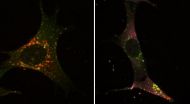(Press-News.org) With their excellent sensitivity and specificity, the use of these extremely efficient tests on a world-wide scale would allow us to adapt antibiotic treatments to the individual's needs and to be more successful in controlling antibiotic resistance, particularly in hospitals. These works were published in September in two international reviews:
Emerging Infectious diseases and The Journal of Clinical Microbiology.
These diagnostic tests will allow rapid identification of certain bacteria that are resistant to antibiotics and hence:
Allow us to better adapt the treatment to the infected patients
Avoid the inappropriate use of certain antibiotics, thus avoiding the over-use of certain wide-spectrum antibiotics
Isolate patients infected with these resistant bacteria and thus avoid the development of epidemics in hospitals
There is an ever-increasing number of emerging bacteria that cause cross-border epidemics. Researchers all agree on the fact that it is not the number of bacteria that is the problem, but their increasing resistance to antibiotics. The situation is particularly dramatic for certain species of bacteria, Gram-negative bacilli such as enterobacteriacae .
A worrying situation both for banal infections and for major treatments.
Whereas certain antibiotics such as wide-spectrum cephalosporins used to be reserved for the most serious cases, now there are cases where they are totally inactive against certain bacterial germs and consequently there is no effective antibiotic treatment for these. And so we are now faced with situations where the treatment of banal infection such as urinary or intra-abdominal infections has no effect. And this puts the life of the patients at risk. Every year, an estimated 25,000 deaths in Europe are due to multi-resistance to antibiotics.
Furthermore, the development of resistance to antibiotics affects an entire aspect of modern medicine that needs efficient antibiotics (grafts, transplants, major surgery, reanimation, etc.).
Undetected importation of multiresistant strains from foreign countries can also considerably accelerate the diffusion of this multiresistance phenomenon.
Two ultra-rapid tests: from Red to Yellow
In an attempt to slow down these increasing resistances, the Inserm researchers have developed a system that can rapidly detect the two enzymes responsible for causing resistance to the bacteria of two classes of common antibiotics: wide-spectrum cephalosprins and carpabenems. In these tests, the presence of an enzyme indicates the presence of a resistant bacteria.
These tests (Corba NP test and ESBL NDP test) are based on the acidification properties generated by the activity of the enzymes (ß-lactamases and carbapenemases) when they are in the presence of an antibiotic. If any one of these enzymes is present, the medium becomes acid and the acidity indicator (pH) turns from red to yellow (Figure, Corba NP test).
At present, these tests can be performed using bacteria isolated from urine samples taken during a detected infection, or from bacteria present in stools. The result is obtained in less than 2 hours (compared to 24 to 72 hours using current techniques). These tests are highly sensitive and highly reliable (100%). They are totally inoffensive since they are carried out on bacteria isolated from patients or on biological products such as urine, etc.
Patrice Nordmann, Inserm Research Director and main author of this work, points out that "These tests are currently being assessed in order to ascertain their sensitivity directly from infected sites such as blood or urine".
The invention of these tests is an important breakthrough in the fight against the resistance to antibiotics. These tests will provide a simple, inexpensive (less than 4 to 5 euros) means of very rapidly detecting the most serious cases of resistance to antibiotics in human medicine and will contribute to limiting international diffusion.
As Patrice Normann states "We can hope, in particular in many Western countries where the situation has not yet reached endemic proportions multi-resistances (France, in particular), to be able to preserve to a certain extent the efficiency of wide-spectrum cephalosporins and carbapenems, antibiotics used as a "last resource".
Used straight at the patient's bedside, these tests will help us to optimise the use of antibiotic treatment, in particular in the developing countries where the levels of resistance are extremely high.
Two international patent applications have been filed with Insert Transfert. Their commercialisation is in the course of development and they should be available in about 12-16 months, however the techniques are available for any specialised laboratories who wish to develop them.
### For more information
Rapid detection of carbapenemase-producing Enterobacteriacae.
Nordmann P, Poirel L, Dortet L.
Patrice Nordmann (Professor, Faculty of Medecine, Paris Sud, Head of Department at the Bicêtre Hospital, AP-HP, Paris)
Laurent Poirel (INSERM researcher)
Laurent Dortet (Teaching hospital assistant lecturer, Faculty of Medecine, Paris Sud)
Emerging Infectious diseases http://dx.doi.org/10.3201/eid1809.120355 (September 2012)
Rapid detection of extended-spectrum ß-lactamase producing Enterobacteriacae.
Nordmann P. Dortet L, Poirel L
Journal of Clinical Microbiology http://dx.doi.org/10.1128/JCM.00859-12 (September 2012)
Development of 2 tests for rapid diagnosis of resistance to antibiotics
2012-10-12
ELSE PRESS RELEASES FROM THIS DATE:
Scientists identify trigger for explosive volcanic eruptions
2012-10-12
Scientists from the University of Southampton have identified a repeating trigger for the largest explosive volcanic eruptions on Earth.
The Las Cañadas volcanic caldera on Tenerife, in the Canary Islands, has generated at least eight major eruptions during the last 700,000 years. These catastrophic events have resulted in eruption columns of over 25km high and expelled widespread pyroclastic material over 130km. By comparison, even the smallest of these eruptions expelled over 25 times more material than the 2010 eruption of Eyjafjallajökull, Iceland.
By analysing ...
The body's own recycling system
2012-10-12
Almost everything that happens inside a cell, including autophagy, is tightly regulated on a biochemical level. Like that, the cell makes sure that processes only take place when they are needed and that they are shut off when the need has expired. "Inside the cell, there exists a network of molecules. Between them, information is constantly being exchanged," says Schmitz, head of the research group "Systems-oriented Immunology and Inflammation Research" at HZI, who also holds a chair at the Otto von Guericke University in Magdeburg. "In a way, it looks like a big city ...
The worst noises in the world: Why we recoil at unpleasant sounds
2012-10-12
In a study published in the Journal of Neuroscience and funded by the Wellcome Trust, Newcastle University scientists reveal the interaction between the region of the brain that processes sound, the auditory cortex, and the amygdala, which is active in the processing of negative emotions when we hear unpleasant sounds.
Brain imaging has shown that when we hear an unpleasant noise the amygdala modulates the response of the auditory cortex heightening activity and provoking our negative reaction.
"It appears there is something very primitive kicking in," says Dr Sukhbinder ...
Kidney grafts function longer in Europe than in the United States
2012-10-12
Kidney transplants performed in Europe are considerably more successful in the long run than those performed in the United States. While the one-year survival rate is 90% in both Europe and the United States, after five years, 77% of the donor kidneys in Europe still function, while in the United States, this rate among white Americans is only 71%. After ten years, graft survival for the two groups is 56% versus 46%, respectively. The lower survival rates compared to Europe also apply to Hispanic Americans, in whom 48% of the transplanted kidneys still function after ten ...
Neuroscientists from Louisiana Tech University to present at international conference
2012-10-12
RUSTON, La. – Dr. Mark DeCoster, the James E. Wyche III Endowed Professor in Biomedical Engineering at Louisiana Tech University, will lead a team of Louisiana Tech neuroscientists in presenting a lecture at the Society for Neuroscience's (SfN) annual meeting, October 15 in New Orleans.
The lecture titled, "Randomization of submaximal glutamate stimulus to interpret astrocyte effect on calcium dynamics," will be featured as part of Neuroscience 2012 – SfN's annual meeting that provides the world's largest forum for neuroscientists to debut research and network with colleagues ...
'Invisibility' could be a key to better electronics
2012-10-12
CAMBRIDGE, Mass. — A new approach that allows objects to become "invisible" has now been applied to an entirely different area: letting particles "hide" from passing electrons, which could lead to more efficient thermoelectric devices and new kinds of electronics.
The concept — developed by MIT graduate student Bolin Liao, former postdoc Mona Zebarjadi (now an assistant professor at Rutgers University), research scientist Keivan Esfarjani, and mechanical engineering professor Gang Chen — is described in a paper in the journal Physical Review Letters.
Normally, electrons ...
Prostate cancer: Curcumin curbs metastases
2012-10-12
Powdered turmeric has been used for centuries to treat osteoarthritis and other illnesses. Its active ingredient, curcumin, inhibits inflammatory reactions. A new study led by a research team at Ludwig-Maximilians-Universität (LMU) in Munich now shows that it can also inhibit formation of metastases.
Prostate cancer is one of the most prevalent malignancies in the Western world, and is often diagnosed only after metastatic tumors have formed in other organs. In three percent of cases, these metastases are lethal. A research team led by PD Dr. Beatrice Bachmeier at LMU ...
Scientists uncover diversion of Gulf Stream path in late 2011
2012-10-12
At a meeting with New England commercial fishermen last December, physical oceanographers Glen Gawarkiewicz and Al Plueddemann from the Woods Hole Oceanographic Institution (WHOI) were alerted by three fishermen about unusually high surface water temperatures and strong currents on the outer continental shelf south of New England.
"I promised them I would look into why that was happening," Gawarkiewicz says.
The result of his investigation was a discovery that the Gulf Stream diverged well to the north of its normal path beginning in late October 2011, causing the warmer-than-usual ...
Cells control energy metabolism via hedgehog signalling pathway
2012-10-12
This press release is available in German.Cancer, diabetes, and excess body weight have one thing in common: they alter cellular metabolism. Scientists from the Max Planck Institute of Immunobiology and Epigenetics in Freiburg and the Medical University of Vienna together with an international research team have jointly resolved a new molecular circuit controlling cellular metabolism. The previously unknown signalling pathway, acting downstream of the hedgehog protein enables muscle cells and brown fat cells to absorb sugars without relying on insulin. Substances that selectively ...
Stem cells from muscle tissue may hold key to cell therapies for neurodegenerative diseases
2012-10-12
WINSTON-SALEM, N.C. – Oct. 12, 2012 – Scientists at Wake Forest Baptist Medical Center have taken the first steps to create neural-like stem cells from muscle tissue in animals. Details of the work are published in two complementary studies published in the September online issues of the journals Experimental Cell Research and Stem Cell Research.
"Reversing brain degeneration and trauma lesions will depend on cell therapy, but we can't harvest neural stem cells from the brain or spinal cord without harming the donor," said Osvaldo Delbono, M.D., Ph.D., professor of internal ...


